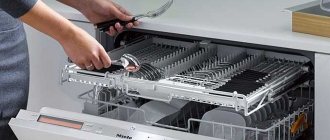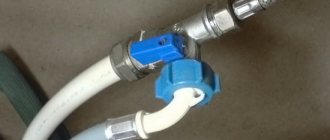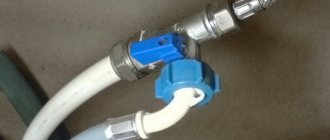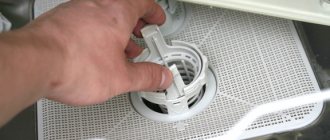The first reason is condensation drying.
When your dishwasher is running on condensation drying, it is almost impossible to get a perfect result. If the dishes are clean, but small drops of water remain on them, this is normal with such functionality . The fact is that at the final stage of washing the items are rinsed with hot water. Then it evaporates and settles in the form of drops on the metal of the case and metal utensils. Sometimes drops remain on glass and ceramic objects.
You just have to come to terms with such results. The only advice I can give is to open the door slightly immediately after completing the work cycle . You can open and close it without waiting for a click. After 20-30 minutes, remove the dry utensils.
Problem with condensation dryer
If the lack of drying is the result of a breakdown, then it must be repaired. Why doesn't my dishwasher dry my dishes? The main reasons for the lack of drying or its poor quality are:
- Failure of the heating element.
- The temperature sensor is not working correctly or is broken.
- Failure of the temperature control relay.
Machine with condensation and heat exchange drying.
If the water heating element fails, it will be immediately noticeable. As a rule, the quality of dishwashing also suffers. The water in the machine will not heat up to the required temperature, and the dishwashing process will take place in cold water. In this case, the most dried dishes will not have time to be washed. Therefore, if you notice that the quality of washing has dropped sharply, and the dishes are cold and wet after washing, then this is the first sign of the need for repairs.
The heating element is considered unsuitable for repair. If it breaks or performs poorly, it must be completely replaced with a new one.
If the heating element is broken
The heating element (heating element) is responsible for heating the water, and in addition, for drying the washed dishes. If the heating element is burnt out, the dishwasher will not heat the water and dry the dishes. It is forbidden to repair the heating element yourself. It is prohibited to use a repaired (restored) heating element for replacement. Failure to do so may result in electric shock or fire to users.
To continue the life of the heating element, it is recommended to use water softeners when washing dishes.
For particularly careful users who do not want to wash their dishes using such products, it is recommended to run a long wash cycle once a week in an empty machine, with the addition of a descaling agent. For machines with ceramic heating elements, the product is selected individually.
If the temperature sensor is broken
If the temperature sensor is broken, the machine will heat the water, but not to the required temperature. The water may not heat up at all if the sensor receives an incorrect signal. The sensor also needs to be completely replaced, since it is technically impossible to fix it.
When replacing a sensor, it is important to respect its model. Sensors from different models of dishwashers can differ significantly in parameters. Installing a working sensor from another model may not bring the expected result.
Broken control relay
If the control relay itself is broken, the machine will not receive the desired temperature setting. The control unit and the washing program will assume that the desired temperature that the user wants is set and will honestly work out the program according to the given setting.
In this case, you will have to reprogram the module or completely replace it. In the event of a breakdown, the control relay is also replaced with a new one. This part cannot be restored.
Reason two - malfunctions
Most of the problems that cause poor drying are due to heating problems - this is what many years of practice have demonstrated.
If there is no required heating, the picture will be as follows:
- water does not evaporate from the plates at all during condensation drying;
- Dishes remain wet due to the injection of cold rather than hot air in machines with a fan and turbo dryer.
In addition to wet utensils as such, you can observe additional signs of malfunctions, such as poor quality of washing, accumulation of water in the lower part of the chamber, malfunctions in operating modes, etc.
The heating element has failed
The function of this unit is aimed at heating water and ensuring dry dishes. If it stops working, you will immediately see it: when there is no heat in the machine, traces of food remain on the plates and the device refuses to dry . First of all, it makes sense to check the serviceability of the heaters; a multimeter is used for diagnostics.
What to do if your dishwasher doesn't wash dishes well
Most modern models use a flow-through heating element located in the lower part of the body. Access requires removal of the bottom panel. Here you can see the most common source of malfunction - scale. So I advise you to initially set the correct water hardness and carry out preventive cleaning. If the heater still fails, it is replaced with a new one. There is no other way out here.
Thermal sensor is broken
The sensor measures the water temperature. The received data is sent to the control board, which commands the heater to dry or heat. This unit is located in the opening of the chamber where water is collected, and a turbidity sensor is often located right there.
If the temperature sensor is broken, the brain of the dishwasher does not receive the appropriate information, and the heating element does not receive commands. The dishwasher stops drying and washing dishes efficiently . In the event of such a problem, the sensor is replaced with a new one, for which the wires are removed and repairs are carried out. To check the functionality, the machine is tested in operating mode.
Care and operation of electrical parts and drains of dishwashers
The control module itself is faulty
With such a failure, the machine will not start the drying cycle at all , and no wonder, because the control module is the brain of the device, responsible for performing all functions. It is he who distributes software commands to all key nodes.
The board is placed inside the door. To access the unit, it is disassembled by unscrewing several bolts. Repairs can be different, sometimes it is enough to reprogram the module by flashing it. Other times a complete replacement is required, which will be more expensive.
If the machine is running on turbo drying
When the model operates on this type of drying, which, by the way, is typical for the premium segment, a breakdown may be indicated by the absence of fan sound . But, on the other hand, during the cycle there are various extraneous noises coming from the machine. Hot air stops flowing to the dishes and they remain damp.
As a rule, it is necessary to replace the unit with a working one. I note that in different models the fan is located differently. In AEG devices - in the upper part of the chamber, in Bosch - in the lower part. Access often requires almost complete disassembly of the equipment, which requires only a professional approach .
Broken heating element and temperature sensor
If the heating element and temperature sensor fail, only complete replacement of the elements is possible. Diagnosing a broken heating element in general is not difficult; this will require skills in working with a multimeter. In most dishwasher models, including Bosch, the heating element is flow-through and is located in the lower part. In order to get it out you will have to turn the car over and remove the bottom part. Next is the heating element, checked for functionality and, if necessary, replaced with a new one, preferably original. The whole process is described in more detail in the article Replacing the heating element in a dishwasher.
As for the temperature sensor, in working condition it regulates the operation of the heating element, giving a command to dry the dishes. If the sensor fails, then the heating element does not receive a command, drying does not begin, and in some cases the process stops even at the stage of washing the dishes. The temperature sensor is located in the opening of the chamber designed to collect water. In some dishwasher models, the same chamber may also contain a water purity sensor. The wires are removed from the temperature sensor, and then the sensor itself is taken out. A new sensor is installed in place of the old one and the repair will be completed; all that remains is to assemble the car and test it.
For your information! In LG dishwashers, the temperature sensor is located at the base of the heating element, just like in washing machines.
Fan and relay are faulty
One of the common reasons that a dishwasher does not dry dishes is a faulty relay located on the control board. In most cases (in fully built-in or free-standing machines), the control board is located inside the door, which can be easily disassembled by unscrewing a few bolts.
Having taken out the control board, you will see a relay on it, replacing which will require some skill when working with a soldering iron. If you doubt that you can cope with such work, it is better to contact a specialist who will do everything for sure. Replacing a relay is an inexpensive repair.
As for the fan in machines with a turbo dryer, if it breaks down it also needs to be replaced; it cannot be repaired. When the fan stops working, you will not hear the characteristic sound when the turbo dryer is operating. The fan that pumps hot air is located differently in different machine models, mainly on the side wall, in Bosch models in the lower part of the chamber, and in AEG machines, on the contrary, in the upper part. Therefore, to get to it, you will have to disassemble almost the entire dishwasher. To avoid this, you can entrust the work to a specialist, which will cost about 2,000 rubles, plus the cost of the fan itself.
Thus, there may be several reasons why a dishwasher does not dry dishes well or does not dry them at all. All of them are easily removable and do not cause any special problems, good luck with your repair!
Interesting:
- Dishwasher rating 45 cm
- Repairs and malfunctions of various dishwashers
- Types of drying in dishwashers
- How to use a dishwasher correctly
- What types of dishwashers are there? Types and types
- What is a dishwasher?
Reader comments
- Share your opinion - leave a comment
conclusions
The source of the dishwasher not drying water could be anything. Sometimes it’s a banal oversight by the manufacturer; I won’t rule out the possibility of a manufacturing defect. In the latter case, I advise you to contact a service center - here you can solve the problem with minimal financial losses.
Even knowing the cause of the breakdown, I advise you to exclude self-repair by contacting a professional . This way, the performance of the equipment will be restored quickly and at a high quality level. Today, the cost of repairs associated with poor drying does not exceed 2.5-3 thousand rubles. I will not tire of repeating that timely prevention will help reduce the risk of malfunctions, so do not neglect the care and descaling of the system.
What to do
First you need to find out what's going on. A visual inspection is necessary. Usually the damage is visible to the naked eye. It is worth inspecting the surface of the device and the camera.
Next, it is advisable to use a multimeter. It can be used to determine which element caused the problem. Regardless of which part is broken, you should contact a specialist. During self-repair, many users damage other elements.
Subscribe to TechnoCouncil on social networks so you don’t miss anything:
Troubleshooting
Below we will look at ways to replace parts; as for the heating element and temperature sensor, in case of their breakdown, only complete replacement of their components will help. Below is a detailed description of each element:
- In almost all Bosch dishwashers and models from other manufacturers, heating elements are located in the lower part of the structure at the very base. To dismantle it, you will need to turn the unit on its side and remove the pan. You can check its performance using a multimeter. If it is necessary to replace the heating element, it is advisable to use a new and original part;
- The temperature sensor is located in the opening of the chamber, which is designed to discharge water. Be careful, in some models this chamber also has a sensor that measures the purity of the water. Replacing the temperature sensor will not cause any particular difficulties; you will need to remove the wires from it and install a new one in place of the old one. Next, you need to check the functionality of the dishwasher.
Now consider the breakdown of the ventilation system and control relay:
- The relay is located on the control board, which is hidden in the dishwasher door. Having disassembled the door, you will find two such elements there; to replace the relay you will need the skill of using a soldering iron. However, if you are afraid of damaging the board or are not confident in your abilities, it is better to contact a specialist; this repair is not expensive;
- With the ventilation system, everything is more complicated, since it cannot be repaired; only a complete replacement of the unit will help you. It is quite easy to determine that it has stopped working - you will not hear a characteristic sound during the drying process. In all models, the fan is installed differently, it all depends on the design of the dishwasher. You will have to disassemble quite a few parts of the machine to find out where this system is located, if you are not afraid of this then go ahead. But if something happens, it is better to contact a specialist who knows the entire design of the unit.
We looked at the main reasons why a dishwasher does not dry dishes; in some cases, you may need the direct intervention of a technician, since the breakdown may be much more serious than you thought.
What repairs will be required if the machine does not dry dishes?
The technician can change the heating element, fan or sensor. The control system is usually reflashed, but replacement is also possible if the unit is faulty. The technician will be able to name the exact cause of the breakdown, as well as the cost of repairs, only after diagnosis.










